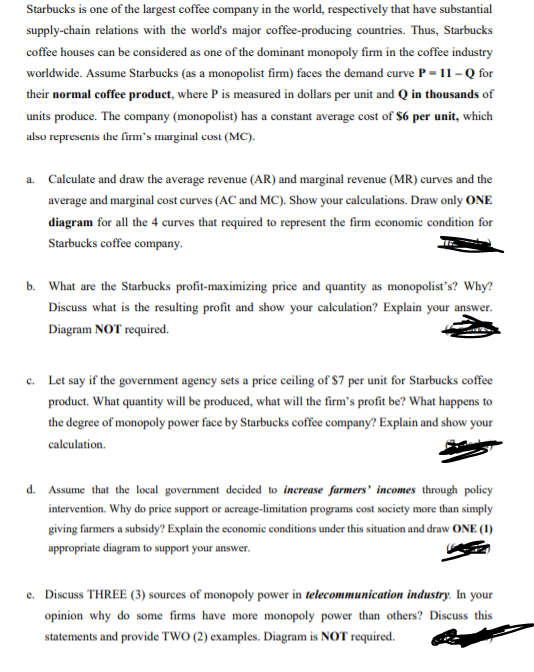supply-chain relations with the world's major coffee-producing countries. Thus, Starbucks coffee houses can be considered as one of the dominant monopoly firm in the coffee industry worldwide. Assume Starbucks (as a monopolist firm) faces the demand curve P- 11- Q for their normal coffee product, where P is measured in dollars per unit and Q in thousands of units produce. The company (monopolist) has a constant average cost of $6 per unit, which ulso represents the firm's marginal cost (MC). a. Calculate and draw the average revenue (AR) and marginal revenue (MR) curves and the average and marginal cost curves (AC and MC). Show your calculations. Draw only ONE diagram for all the 4 curves that required to represent the firm economic condition for Starbucks coffee company.
supply-chain relations with the world's major coffee-producing countries. Thus, Starbucks coffee houses can be considered as one of the dominant monopoly firm in the coffee industry worldwide. Assume Starbucks (as a monopolist firm) faces the demand curve P- 11- Q for their normal coffee product, where P is measured in dollars per unit and Q in thousands of units produce. The company (monopolist) has a constant average cost of $6 per unit, which ulso represents the firm's marginal cost (MC). a. Calculate and draw the average revenue (AR) and marginal revenue (MR) curves and the average and marginal cost curves (AC and MC). Show your calculations. Draw only ONE diagram for all the 4 curves that required to represent the firm economic condition for Starbucks coffee company.
Managerial Economics: Applications, Strategies and Tactics (MindTap Course List)
14th Edition
ISBN:9781305506381
Author:James R. McGuigan, R. Charles Moyer, Frederick H.deB. Harris
Publisher:James R. McGuigan, R. Charles Moyer, Frederick H.deB. Harris
Chapter12: Price And Output Determination: Oligopoly
Section: Chapter Questions
Problem 2E
Related questions
Question
I need A

Transcribed Image Text:Starbucks is one of the largest coffee company in the world, respectively that have substantial
supply-chain relations with the world's major coffee-producing countries. Thus, Starbucks
coffee houses can be considered as one of the dominant monopoly firm in the coffee industry
worldwide. Assume Starbucks (as a monopolist firm) faces the demand curve P = 11 - Q for
their normal coffee product, where P is measured in dollars per unit and Q in thousands of
units produce. The company (monopolist) has a constant average cost of $6 per unit, which
also represents the firm's marginal cust (MC).
a. Calculate and draw the average revenue (AR) and marginal revenue (MR) curves and the
average and marginal cost curves (AC and MC). Show your calculations. Draw only ONE
diagram for all the 4 curves that required to represent the firm economic condition for
Starbucks coffee company.
b. What are the Starbucks profit-maximizing price and quantity as monopolist's? Why?
Discuss what is the resulting profit and show your calculation? Explain your answer.
Diagram NOT required.
c. Let say if the government ageney sets a price ceiling of $7 per unit for Starbucks coffee
product. What quantity will be produced, what will the firm's profit be? What happens to
the degree of monopoly power face by Starbucks coffee company? Explain and show your
caleulation.
d. Assume that the local government decided to increase farmers' incomes through policy
intervention. Why do price support or acreage-limitation programs cost society more than simply
giving farmers a subsidy? Explain the economic conditions under this situation and draw ONE (1)
appropriate diagram to support your answer.
e. Discuss THREE (3) sources of monopoly power in telecommunication industry. In your
opinion why do some firms have more monopoly power than others? Discuss this
statements and provide TWO (2) examples. Diagram is NOT required.
Expert Solution
This question has been solved!
Explore an expertly crafted, step-by-step solution for a thorough understanding of key concepts.
Step by step
Solved in 2 steps with 2 images

Knowledge Booster
Learn more about
Need a deep-dive on the concept behind this application? Look no further. Learn more about this topic, economics and related others by exploring similar questions and additional content below.Recommended textbooks for you

Managerial Economics: Applications, Strategies an…
Economics
ISBN:
9781305506381
Author:
James R. McGuigan, R. Charles Moyer, Frederick H.deB. Harris
Publisher:
Cengage Learning



Managerial Economics: Applications, Strategies an…
Economics
ISBN:
9781305506381
Author:
James R. McGuigan, R. Charles Moyer, Frederick H.deB. Harris
Publisher:
Cengage Learning





Microeconomics: Principles & Policy
Economics
ISBN:
9781337794992
Author:
William J. Baumol, Alan S. Blinder, John L. Solow
Publisher:
Cengage Learning